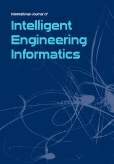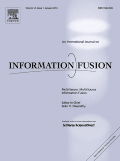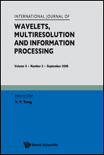
Traitement du Signal
Scope & Guideline
Exploring New Horizons in Signal Technologies
Introduction
Aims and Scopes
- Signal Processing Techniques:
Research in this area covers a wide range of signal processing methods applied to audio, image, and biomedical signals, including noise reduction, feature extraction, and real-time processing. - Machine Learning and Deep Learning Applications:
The journal prominently features studies that apply machine learning and deep learning methodologies to enhance classification, detection, and prediction tasks across various fields such as healthcare, agriculture, and environmental monitoring. - Image Analysis and Processing:
This encompasses techniques for image enhancement, segmentation, and recognition, particularly in medical imaging, remote sensing, and industrial applications. - Biomedical Signal Processing:
Focus on the application of signal processing in biomedical contexts, including EEG, ECG, and other physiological signals for disease detection and health monitoring. - Multimodal Data Integration:
Research that integrates data from multiple sources or modalities, leveraging diverse datasets to improve analysis and prediction accuracy. - Robustness and Optimization Techniques:
Studies aimed at improving the robustness of algorithms against noise and other interferences, along with optimization strategies for enhancing performance.
Trending and Emerging
- Deep Learning for Image Classification:
There is a significant increase in papers utilizing deep learning techniques for image classification tasks, particularly in medical imaging, demonstrating the growing importance of AI in healthcare. - Real-Time Processing Applications:
Research focused on real-time signal processing applications, especially in fields like autonomous driving and smart cities, is gaining momentum, reflecting advancements in technology and the demand for immediate data analysis. - Multimodal and Cross-Modal Learning:
Emerging interest in integrating data from multiple modalities (e.g., combining audio, video, and sensor data) to enhance recognition and classification tasks is a notable trend. - AI and Machine Learning in Healthcare:
The application of AI and machine learning for diagnostic purposes in healthcare, including disease detection and prognosis, is increasingly prevalent, showcasing the journal's commitment to impactful research. - Sustainability and Environmental Monitoring:
An uptick in studies focusing on using signal processing for environmental applications, such as remote sensing for climate change monitoring and agriculture, highlights the journal's alignment with global sustainability efforts.
Declining or Waning
- Traditional Signal Processing Methods:
There is a noticeable decrease in publications focused solely on classical signal processing techniques without the integration of machine learning or advanced computational methods. - Basic Image Processing Techniques:
Research that deals with fundamental image processing techniques, such as basic filtering or thresholding, appears to be waning as more complex methodologies gain traction. - Generalized Applications without Specific Focus:
Papers that present broad applications of signal processing without a clear, novel contribution or specific focus are being published less frequently. - Hardware Implementation Studies:
While hardware implementations remain relevant, there seems to be a declining trend in articles focused solely on hardware aspects, as the emphasis shifts towards software solutions and algorithmic innovation.
Similar Journals

International Journal of Intelligent Engineering Informatics
Pioneering Research at the Intersection of Technology and Intelligence.International Journal of Intelligent Engineering Informatics, published by INDERSCIENCE ENTERPRISES LTD, stands at the forefront of research in the interdisciplinary domains of computer science, artificial intelligence, and human-computer interaction. With an ISSN of 1758-8715 and E-ISSN of 1758-8723, this journal serves as a vital resource for researchers and professionals seeking to explore the latest advancements in intelligent engineering and informatics techniques crucial for the evolution of modern technologies. Although currently not an open-access publication, it provides a necessary platform for disseminating high-quality research; its impact factor continues to grow, attracting a diverse readership interested in signal processing, software development, and computer vision. Covering innovative topics from 2022 to 2024, the journal is committed to fostering scholarly dialogue that paves the way for emerging trends and applications in the field, ensuring its relevance and significance in today's rapidly advancing technological landscape.

MULTIMEDIA SYSTEMS
Pioneering Research in Multimedia SystemsMULTIMEDIA SYSTEMS, published by SPRINGER, is a premier academic journal dedicated to the dynamic field of multimedia technology and its applications across various domains. With the ISSN 0942-4962 and E-ISSN 1432-1882, this journal has established itself as an essential resource since its inception in 1993, providing researchers and professionals with rigorous peer-reviewed articles that explore innovative developments in Media Technology, Computer Networks, Hardware Architecture, Information Systems, and Software. As a testament to its academic impact, MULTIMEDIA SYSTEMS has attained a Q2 ranking in multiple key categories for 2023, alongside a notable Q1 ranking in Media Technology, highlighting its significance within the community. With a rich repository of knowledge and ongoing commitment to advancing multimedia research, this journal is an invaluable asset for those seeking to stay informed about cutting-edge technologies and methodologies. While the journal follows a traditional subscription model and is not presently open access, it ensures high-quality content that serves the scholarly needs of its audience, facilitated by its accessibility from Germany's respected academic infrastructures. For inquiries and submissions, the journal is based in New York, NY, further illustrating its global academic reach.

Journal of Signal Processing Systems for Signal Image and Video Technology
Unveiling Cutting-edge Developments in Signal Processing Systems.Journal of Signal Processing Systems for Signal Image and Video Technology, published by SPRINGER, is a leading interdisciplinary journal dedicated to advancing research and development in the fields of signal processing, image processing, and video technology. With an ISSN of 1939-8018 and an E-ISSN of 1939-8115, this journal emphasizes both theoretical and practical applications, boasting a wide scope that ranges from control and systems engineering to hardware architecture. Since its inception in 2008, it has gained a solid reputation, reflected in its 2023 category quartile rankings—including Q2 in Control and Systems Engineering and Q3 in Signal Processing—demonstrating its significance within the academic community. The journal is underpinned by a commitment to open access, promoting broad dissemination of knowledge, and is particularly vital for researchers, professionals, and students looking to contribute to and stay updated in these rapidly evolving fields. With ongoing explorations into the convergence of technology and methodology until 2024, the journal stands as a crucial resource for the latest innovations and discussions in signal processing systems.

Information Fusion
Bridging Theory and Practice for a Smarter Tomorrow.Information Fusion is a premier journal published by Elsevier, specializing in cutting-edge research within the fields of hardware and architecture, information systems, signal processing, and software. With a significant impact factor, it remains at the forefront of academic discourse, boasting a remarkable Q1 ranking in each of its categories in 2023, which underscores its critical role in advancing knowledge and innovation in these domains. The journal, with ISSN: 1566-2535 and E-ISSN: 1872-6305, is dedicated to fostering collaboration and the dissemination of research findings that drive technological advancements and improve system efficiencies. Researchers, professionals, and students alike will find a wealth of valuable insights into emerging methodologies, trends, and applications. Designed to bridge the gap between theory and practice, Information Fusion invites contributions that enrich the academic landscape and provoke engaged discussions among the scholarly community.

IMAGING SCIENCE JOURNAL
Exploring New Dimensions in Visual TechnologyImaging Science Journal, published by Taylor & Francis Ltd, serves as a vital resource for researchers and professionals in the fields of computer vision, pattern recognition, and media technology. With an ISSN of 1368-2199 and an E-ISSN of 1743-131X, this journal has been fostering scholarly dialogue since its inception in 1997, with a converged content offering extending through 2024. Its categorization in Quartile 4 in Computer Vision and Pattern Recognition and Quartile 3 in Media Technology highlights its relevance and contributions to emerging trends in these domains. Although it ranks 36th in the Engineering - Media Technology category and 96th in Computer Science - Computer Vision and Pattern Recognition, its innovative research and insights continue to attract the attention of scholars dedicated to advancing knowledge at the intersection of imaging technologies. Offering versatile access options, this journal is essential for students, researchers, and professionals aiming to stay informed and engaged in the rapidly evolving landscape of imaging science.

International Arab Journal of Information Technology
Empowering Research, Shaping the Future of ITWelcome to the International Arab Journal of Information Technology, a prestigious publication under the aegis of ZARKA PRIVATE UNIVERSITY in Jordan, dedicated to advancing the field of Information Technology. First established in 2008, this journal has made significant strides in disseminating high-quality research, achieving an impressive Q2 ranking in Computer Science (miscellaneous) and securing a notable 57th percentile position in the Scopus rankings. With a comprehensive scope encompassing various sub-disciplines of computer science, the journal is committed to promoting scholarly dialogue and innovation among researchers, professionals, and students. While currently operating as a subscription-only journal, it remains a vital resource for the academic community seeking to explore the latest trends and advancements in technology. The International Arab Journal of Information Technology is not only a platform for original research but also a vibrant hub for ideas that shape the technological landscape of the Arab region and beyond.

DIGITAL SIGNAL PROCESSING
Advancing the Frontiers of Digital Signal ProcessingDIGITAL SIGNAL PROCESSING is a leading academic journal published by Academic Press Inc Elsevier Science, serving as a vital resource in the fields of applied mathematics, artificial intelligence, signal processing, and electrical engineering. With an impressive set of rankings, including a Q2 designation in multiple categories such as Applied Mathematics and Computer Vision and Pattern Recognition, this journal aims to disseminate high-quality research that addresses both theoretical and practical aspects of digital signal processing. Its rigorous peer-review process ensures the publication of original articles, review papers, and innovative applications, making it an essential platform for researchers and professionals dedicated to advancing this dynamic field. While currently not an open-access journal, it maintains a significant impact factor, reflecting its esteemed position within the academic community. The journal's ongoing commitment to exploring new trends and methodologies positions it at the forefront of digital signal processing research, driving both scholarly inquiry and practical application from 1991 to 2024.

NETWORK-COMPUTATION IN NEURAL SYSTEMS
Unlocking the Secrets of Neural Networks Through ComputationNETWORK-COMPUTATION IN NEURAL SYSTEMS is a distinguished journal published by Taylor & Francis Inc, focusing on the innovative intersection of network theory and neural computation. Since its inception in 1990, this journal has provided a vital platform for researchers and professionals in the field of neuroscience, exploring the dynamics of neural networks and computational models. With its current Q3 category ranking in Neuroscience (miscellaneous) and a robust position in Scopus, the journal plays a critical role in advancing knowledge and discussion within this interdisciplinary area. The journal addresses a wide range of topics related to the computational aspects of neural systems, fostering collaboration and providing valuable insights amongst scholars. Although it is not an open-access publication, its well-curated content remains accessible through institutional subscriptions, ensuring that significant research reaches the hands of those who need it. As it continues to evolve through 2024 and beyond, NETWORK-COMPUTATION IN NEURAL SYSTEMS stands as a key resource for anyone deeply engaged in understanding the complexities and intricacies of neural computations.

International Journal of Wavelets Multiresolution and Information Processing
Bridging Mathematics and Technology with Wavelet ResearchWelcome to the International Journal of Wavelets, Multiresolution and Information Processing, a leading platform published by World Scientific Publishing Co. Pte Ltd that explores the intricate intersections of applied mathematics, signal processing, and information systems. Since its inception in 2006, this journal has provided a robust avenue for scholars and practitioners to disseminate innovative research and developments in wavelet theory and its multidisciplinary applications, providing valuable insights into complex problem-solving across various fields. With an impact factor that reflects its rigorous peer-review process and commitment to quality, the journal holds a commendable Q3 category ranking in Applied Mathematics, Information Systems, and Signal Processing as of 2023. The journal is housed in Singapore and serves a global audience, ensuring that groundbreaking research is accessible to all. Emphasizing open discourse and collaboration, the International Journal of Wavelets, Multiresolution and Information Processing is an essential resource for researchers, professionals, and students aiming to advance their understanding and practical use of wavelet and multiresolution techniques.

SIGNAL PROCESSING-IMAGE COMMUNICATION
Transforming Ideas into Visual SolutionsSIGNAL PROCESSING-IMAGE COMMUNICATION, published by Elsevier, is a leading journal in the fields of Computer Vision, Signal Processing, and Electrical Engineering. With an impressive range of Quartile rankings in 2023, including Q1 in Electrical and Electronic Engineering and Q2 in Signal Processing, this journal is vital for researchers and professionals seeking the latest advancements and comprehensive studies in image communication technologies. Issued in the Netherlands, SIGNAL PROCESSING-IMAGE COMMUNICATION has been an essential resource since its inception in 1989, fostering innovation and collaboration among academia and industry. The journal provides a platform for high-quality peer-reviewed research, addressing significant challenges and solutions in the convergence of image processing and communication. Although currently not an Open Access journal, it offers subscription options that ensure a broad dissemination of groundbreaking knowledge. With a robust reputation reflected in its Scopus ranks, this journal serves as an indispensable reference for students and experts aiming to stay at the forefront of developments in this dynamic field.